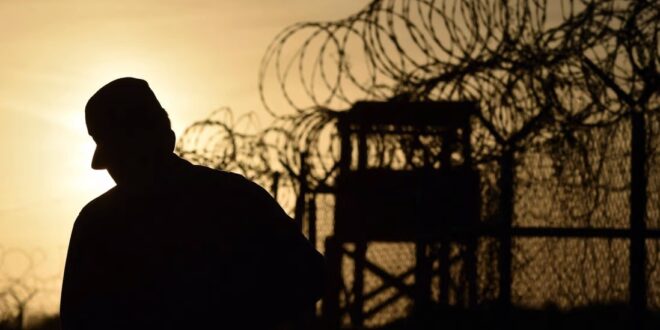The alleged mastermind of the Bali bombings put Southeast Asia’s violent extremists on a collision course with the US and its allies
Two decades on, his actions continue to reverberate – not least in the Jemaah Islamiah-linked schools that are the ‘Ivy League’ of Indonesia’s jihadi universe
Two decades after Singapore began cracking down on a pan-Southeast Asia terrorist group calling itself Jemaah Islamiah (JI), the network’s operations leader, Hambali, remains at Guantanamo Bay awaiting trial. The evidence against him shows that he took orders and money from the al-Qaeda mastermind behind 9/11 to stage terrorist attacks in the region, including the deadly Bali bombings in 2002, and was planning yet more attacks when captured in 2003. In the second of a two-part feature, Susan Sim, who was a journalist in Jakarta during the events of September 11, 2001, takes a look at his legacy of mayhem.
In late August this year, a US military commission in Guantanamo Bay charged Hambali and two Malaysians he had recruited for an aborted al-Qaeda suicide attack on the United States – Mohd Farik bin Amin, alias Zubair, and Mohammed Nazir bin Lep, alias Lillie – with conspiracy, murder, terrorism and attacking civilians.
The charges centred on two terrorist attacks in Indonesia where Americans had been among the casualties. Hambali himself does not appear to dispute his involvement in both attacks. But the charge sheet also implicates him in every significant JI activity up to and a year beyond his capture.
In addition to his planning of the Bali bombing and facilitating the financing of the Jakarta Marriott Hotel bombing he is accused of scheming with senior al-Qaeda leaders to carry out post-9/11 attacks against US interests; a plot to use an all-Malaysian cell to hijack an aeroplane and fly it into the Library Tower (now known as the US Bank Tower) in Los Angeles; and helping al-Qaeda develop an anthrax programme by providing Malaysian microbiologist Yazid Sufaat.
When a summary was read out to Hambali during a hearing in March 2016 to determine if his “continued law-of-war detention” was warranted, his response, as read out by his personal representatives and publicly released, was that “he wants nothing more than to move on with his life and be peaceful. He hopes to remarry and have children to raise.”
During his time at Guantanamo, Hambali had learned English and taught himself Arabic and “enjoys watching the programmes Planet Life [and] Blue Planet” on DVD, they said, adding: “His father and uncles were all teachers, so [studying] came naturally for him.”
While mostly compliant, Hambali’s jailers noticed that he did use the daily prayers and lectures he led to “promote violent jihad” among fellow detainees, and said they believed he was using his language classes and status as “teacher” to exert undue influence over others.
Then, as now, Hambali’s pleasant demeanour and religious knowledge is thought to have helped him recruit acolytes and command their loyalty. But not all those who plotted alongside him were so enamoured by his leadership.
Ali Ghufron, a JI leader better known as Mukhlas who was executed in 2008 by Indonesia for his role in the Bali bombings, happily provided photo identification of Hambali to Thai investigators – apparently aggrieved that Khalid Sheikh Mohammed (KSM) had named the younger man leader of al-Qaeda operations in Southeast Asia despite him being two years Mukhlas’ junior, and having trained in Afghanistan at a later date.
Armed with this photo, Thai Police Major-General Tritot Ronnaritivichai spent almost eight months hunting Hambali in 2003. With the country hosting the Asia-Pacific Economic Cooperation forum that year, he could not afford to have a wanted terrorist – who US and regional security services had announced was based in Bangkok – on the loose, he told me when we met five years later.
Hambali was indeed plotting more attacks at this time, as Tritot would discover after the arrest of Malaysian co-conspirator Mohd Farik bin Amin, alias Zubair, in June 2003.
Thai investigators captured Zubair while on the trail of a more elusive target: Mohammed Nazir bin Lep, a Malaysian better known in JI circles as Lillie who police knew had been in contact with one of KSM’s couriers, though they did not know what Lillie looked like.
Tritot’s team, working alongside the US Central Intelligence Agency (CIA), tracked Lillie to a Bangkok building where they jammed the mobile phone signal in an attempt to flush him out. Soon enough, a man emerged who Tritot said “just looked out of place” and the police swooped in.
But the foreigner was Zubair, who for a month after his arrest kept silent – both to protect Hambali’s plans, and to stop the authorities knowing how close they had come to getting their man. Lillie, as Tritot would later realise while reviewing a video recording of Zubair’s arrest, had stepped behind a pillar when the police emerged.
In the flat Zubair and Lillie shared, Tritot’s team found a note tucked into the pages of an old newspaper that outlined a plan to use a surface-to-air missile (SAM) to shoot down an Israeli El Air flight taking off from Don Maung airport in Bangkok.
Hambali had wanted to buy an old Vietnam war-era heat-seeking missile from the black market in Cambodia, but Lillie, who had trained to use SAMs in an al-Qaeda camp in Afghanistan in early 2001, knew it required a trigger component not easily available. Hambali had also ordered Lillie to survey the Jewish quarter in Bangkok to identify Jewish stores, restaurants and the synagogue and to plan an attack. Lillie, noting the presence of a backpacker’s left-luggage store next to a store selling gas canisters in the vicinity, had suggested that a bomb left in a backpack would have great explosive force when the gas canisters caught fire.
In the end, Hambali was caught because he broke his own rules on operational security. Although he moved every few months with his wife, Hambali stayed in constant communication with other al-Qaeda and JI operatives. He tasked Zubair and Lillie with planning terrorist operations, casing targets, and facilitating money transfers, and they left trails that eventually led to his hideout when they were caught through a combination of communications intercepts, intelligence sharing by regional security services, surveillance of known criminal syndicates, and old-fashioned police intuition. He appeared to believe his co-conspirators would never betray him.
At the time of Zubair’s arrest, Hambali was in Cambodia with another JI member to plan attacks against Western embassies in Phnom Penh and to buy weapons. On his return to Thailand, he tasked Lillie with obtaining new passports. However, Tritot had anticipated this and had put known forging syndicates under surveillance. Lillie, whose identity Zubair eventually revealed under interrogation, was arrested as soon as he came to collect the fake documents. Unlike Zubair, Lillie broke almost immediately and gave Hambali’s location away – a flat in an area of Ayutthaya city popular with businessmen and workers from South and East Asia.
Tritot learned from Lillie that Hambali was armed with an M16 rifle and two pistols. Wanting to avoid a firefight, the police major-general attempted to lure the terrorist out by getting the building’s landlord to tell him he had a call on the lobby telephone. When the landlord turned heel and ran, however, Hambali spotted Tritot and a brief scuffle ensued.
“He scratched my hand when I grabbed his gun,” Tritot told me, nodding at a framed pistol in his office bearing the legend, “Operation Black Magic, August 11, 2003”. Hambali had left the other Norinco pistol in the flat with his wife.
“Hambali looked surprised when we arrested him but he knew he would be caught if he stayed in Thailand too long,” Tritot said. “He said nothing when we put him in a van to drive straight back to Bangkok.”
It was almost midnight on August 11, 2003, when Tritot began his interrogation of Hambali. “Are you Hambali?” he asked. To his surprise, Hambali replied, “Yes. I surrender to you.”
Tritot told me, half in jest, that when the CIA asked him to provide a code-name for the Hambali operation, he chose “Black Magic” because that was what he used. The CIA told the world it was the waterboarding of al-Qaeda suspects in its black sites that worked magic. In subsequent years, the capture of Hambali became one of the “Eight Most Frequently Cited Examples of Plots Thwarted and Terrorists Captured Provided by the CIA as Evidence for the Effectiveness of the CIA’s Enhanced Interrogation Techniques”, a US Senate report on the CIA’s use of torture noted in 2014. In the CIA’s telling, it was information provided by Majid Khan after being waterboarded and deprived of sleep that led to the capture of Zubair, which subsequently led to Hambali’s location.
The CIA’s representations were “inaccurate”, the Senate report said, concluding instead that “the intelligence that led to Hambali’s capture in Thailand was based on signals intelligence, a CIA source, and Thai investigative activities.”
For years, the CIA also sought to obscure these “Thai investigative activities”. When my friend and colleague Ali Soufan, a decorated former FBI special agent who had opposed the CIA’s use of torture, wrote an account of how Tritot captured Hambali in his 2010 book The Black Banners, the CIA insisted he cut out every word even though none of the material had come from US sources. It was only in 2018, when the Oscar-winning filmmaker Alex Gibney and Pulitzer Prize-winning journalist Raymond Bonner, who were making a documentary about torture, challenged the CIA’s censorship of Ali’s book in court, did the agency reverse this redaction and the numerous other cuts it had demanded on national security grounds.
If there were ever any doubts as to the pivotal role Tritot and his team played in Hambali’s capture, they were dispelled by the CIA’s actions. As Ali and I used to joke, if Tritot’s account were not accurate, why try to censor it? After all, I had seen in Tritot’s office a glass plaque with an embedded bullet that he said the CIA had presented to him. Addressed to him by name and emblazoned with US and Thai flags, the plaque said “H, August 2003, The Right Team At The Right Time”.
The US government’s case against Hambali might have been made stronger by Majid Khan’s plea agreement with a US military court that recently sentenced him to 26 years’ imprisonment; among the charges Khan pled guilty to was one of delivering US$50,000 from al-Qaeda to Hambali to fund the bombing of the Jakarta Marriott Hotel in August 2003.
But if found guilty, might Hambali get a sentence much longer than time served? The US Senate report also revealed that he had been subjected to “enhanced interrogation techniques” in US custody. At his sentencing hearing in late October, Majid Khan provided such graphic descriptions of his torture by the CIA that seven of the eight-member military jury later denounced his brutal treatment as a “stain on the moral fibre of America” and urged clemency on his behalf. Even if that is not granted, Khan’s plea deal means he is eligible to be released as soon as next February.
Hambali has no such plea agreement. Indeed, he refused to take part in his periodic review at Guantanamo Bay in November 2019. The nightmare scenario for Southeast Asia would be if the US, under domestic pressure to close Guantanamo Bay and repatriate detainees to their countries of origin, sent Hambali back to Indonesia to stand trial, or if already tried and sentenced by then, to serve out the remainder of his prison term.
What Hambali wrought
There is no doubt that Hambali helped put Southeast Asia’s violent extremists on a collision course with the US and its allies, against what al-Qaeda calls the “far enemy”.
Hambali had been talent-spotted by the leader of Darul Islam, Abdullah Sungkar himself. Sungkar sent Hambali and others to Afghanistan to acquire military skills to fight the “near enemy” – the Indonesian state – not to join Osama bin Laden’s “vanguard of elite fighters” to take jihad global, to fight what Bin Laden saw as the bigger enemy propping up repressive regimes: the US.
Perhaps Hambali was seduced by what bin Laden offered – money, expertise and training. So too perhaps was the JI leadership; “JI leaders were interested in Osama because of his background – a Saudi millionaire who sacrificed so much,” Nasir Abas told me.
As leader of JI’s Mantiqi 1 cell, and KSM’s representative in Southeast Asia, Hambali was able to hand-pick some 150 Indonesians, Malaysians and Singaporeans to undergo training in terrorist camps in Afghanistan and the southern Philippines between 1997 and 2001, with Imam Samudra, Noordin M Top and Azahari Husin – the men who planned and built the bombs for the Bali and Jakarta attacks – among the first trainees he sent.
But when Hambali began urging attacks on the US, in accordance with a fatwa issued by Bin Laden, some of his fellow JI members said they balked. “We didn’t understand why he was demonising the US. We had a different strategy and many of us had problems with Hambali’s direction,” said one former member. Others questioned why Hambali was seemingly taking orders from the leader of another group.
Undeterred, Hambali ordered members of Mantiqi 1 to join in a series of attacks on Christian churches across Indonesia on Christmas Eve in 2000. He planned the bombings like a gang initiation, a Singapore counterterrorism official later told me, to ensure his recruits’ commitment to the cause – but not everyone was entirely on board.
Ali Imron, currently serving a life sentence in Indonesia for helping to build the bombs used in the 2002 Bali attacks at the behest of his brother Mukhlas, told me in an interview in 2010 that when he asked if the Christmas Eve attack had been sanctioned by JI’s leadership, “Hambali said it was none of my business”.
After agreeing to target a church in East Java, Imron decided to attend a service beforehand – but what he heard made him place the bomb he was carrying in a spot “far from people”, he said.
“I listened to the preacher. He didn’t ask people to attack or hate Muslims,” Imron said. “I was confused. Christians are not against us. Why attack them?”
Imron, who now works on deradicalisation efforts with the Indonesian police, said he had never before told anyone about his actions that day.
“If I had known Hambali was carrying out orders from another group, from al-Qaeda, I wouldn’t have done it. I was betrayed,” he said.
The carnage of the Bali bombings created such a public backlash that the Indonesian police were finally empowered to go after JI. As former national police chief and current Indonesian cabinet member Tito Karnavian once told me, it was a “turning point of Indonesia recognising Jemaah Islamiah as a terrorist group and subsequently revealing the network and finding that the network is quite extensive, encompassing the Southeast Asian region”.
I was confused. Christians are not against us. Why attack them?
Ali Imron
Within a year of the attacks, the Indonesian police – now better equipped, trained and partially funded by Australia and the US – had arrested many of the JI leaders and operatives, and gained intelligence on those who underwent training in Afghanistan and the camps set up by JI in Abu Sayyaf territory in the southern Philippines beginning in 1996.
Several senior JI operatives escaped the dragnet, however, later surfacing in Mindanao where they kept at least one training camp operating.
What remained of JI declared it would henceforth focus on dakwah, or spreading its ideology. When the Australian embassy in Jakarta was bombed in 2004, Bali again in 2005, and two Jakarta hotels in 2009, JI distanced itself from the violence, blaming instead a splinter cell led by the Malaysian terrorist Noordin M Top.
But JI never stopped recruiting. Indeed, it was able to expand its networks by doubling the number of schools controlled by its members and sympathisers in the first 15 years after the Bali bombings. When an Indonesian researcher and I did a study four years ago, we found that the number had grown from about 31 in 2002 to 66 by 2017.
Many of these newer schools are being run by alumni of four well-known JI schools, the “Ivy League” of the Indonesian jihadi universe with its own counterculture and preparation for life as a mujahid (holy warrior). While many of the schools added secular subjects like information technology and English language to their religious curriculum, they remain true to JI founder Abu Bakar Ba’asyir’s vision of the pesantren (religious boarding school) as “a cauldron for the building-up of a cadre of mujahedin”, bringing to life “the spirit of war in the path of God”. Signs in the dormitories urge students to “die as a noble man or die as a martyr”.
The first Indonesian to carry out a suicide bombing for Islamic State (Isis) in Iraq went to one such JI-linked school. At the age of 15, Wildan Mukhallad, a student at the Al-Islam boarding school started by the family of Ali Imron, began dreaming of becoming a suicide bomber after attending the funerals of Imron’s brothers, Amrozi and Mukhlas, following their execution in November 2008. Five years later, Wildan was dead, his death celebrated in a tweet by a pro-Isis account that eulogised him as a martyr who “after one year of performing jihad in Syria together with Isis, died in a martyrdom operation in Iraq”. When word spread among Indonesian jihadi circles, Wildan’s infamy inspired other young Indonesian men to join Isis in Syria.
Faced with competition from acolytes of Isis, JI tried to outbid its rivals by sending some 60 of its most promising cadres to Syria for “exposure”. Pro-Isis elements in Indonesia have, however, staged increasingly audacious terrorist attacks, beginning with a commando-style attack on the streets of central Jakarta in January 2016, the dispatch of fighters to help seize the town of Marawi in the Philippines in the summer of 2017, and at least four successful suicide attacks in Indonesia and the southern Philippines in the last three years.
The Isis groups also proved themselves to be equal opportunity instigators with women taking part in the recent suicide attacks, and in the case of the Surabaya suicide bombings, their children as well.
Still, in a landscape littered with violent actors and too many corpses, no Southeast Asian terrorist has captured the world’s attention as much as Hambali did almost two decades ago. His capture, the CIA said at the time, was the “most significant” since that of his friend and patron KSM.
However long it takes, Hambali’s victims deserve justice. For today’s aspiring jihadis, on the other hand, is Hambali the man merely an artefact of history?
Whatever his currency, the reality is that the consequences of what he did, even if almost two decades old, continue to reverberate in the security landscape of the region today. Therein lies the conundrum for governments – what do you do with Hambali?
 Eurasia Press & News
Eurasia Press & News




